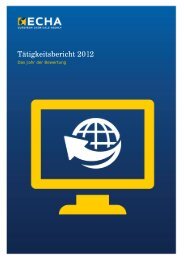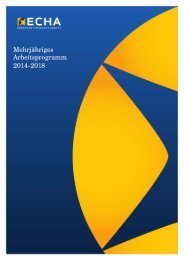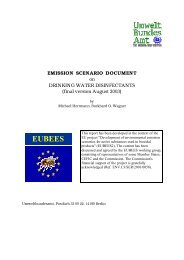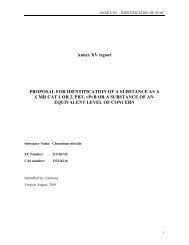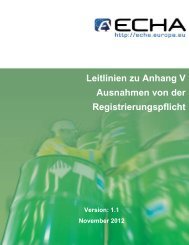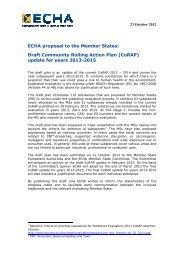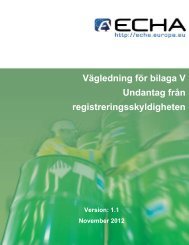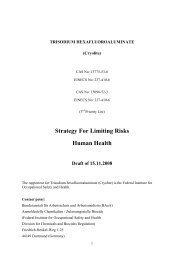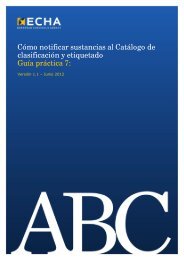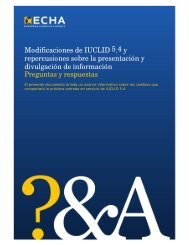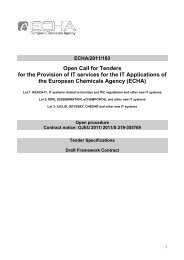Practical Guide 5: How to report (Q)SARs - ECHA - Europa
Practical Guide 5: How to report (Q)SARs - ECHA - Europa
Practical Guide 5: How to report (Q)SARs - ECHA - Europa
You also want an ePaper? Increase the reach of your titles
YUMPU automatically turns print PDFs into web optimized ePapers that Google loves.
classification and labelling and/or risk assessment will be very much endpointdependent.<br />
Additional information might be needed <strong>to</strong> assess the generated prediction<br />
for adequacy in the context of a regula<strong>to</strong>ry decision. Therefore, the validity (are the five<br />
OECD principles on scientific validity of a model fulfilled?), applicability (can reliable<br />
predictions be expected if the model is applied <strong>to</strong> the substance of interest?) and<br />
relevance (is the information generated which is needed for the risk assessment and/or<br />
classification and labelling?) needs <strong>to</strong> be assessed for each individual prediction.<br />
Scientifically valid<br />
(Q)SAR model<br />
Reliable (Q)SAR<br />
result<br />
Adequate<br />
(Q)SAR result<br />
(Q)SAR model<br />
relevant for the<br />
regula<strong>to</strong>ry<br />
purpose<br />
6<br />
(Q)SAR model<br />
applicable <strong>to</strong><br />
query chemical<br />
3.5. <strong>How</strong> do I <strong>report</strong> a (Q)SAR prediction in IUCLID 5?<br />
To <strong>report</strong> a (Q)SAR prediction in IUCLID 5, the following information has <strong>to</strong> be provided:<br />
1. Information on the validity of the (Q)SAR model.<br />
2. Verification that the substance falls within the applicability domain of the (Q)SAR<br />
model.<br />
3. Assess the adequacy of the results for the purpose of classification and labelling<br />
and/or risk assessment.<br />
The information on these three points should be compiled according <strong>to</strong> the (Q)SAR<br />
Prediction Reporting Format (QPRF). See the Guidance on information requirements<br />
and chemical safety assessment, Chapter R.6: (Q)<strong>SARs</strong> and grouping of chemicals<br />
(R.6.1.10.1) for more details on QPRF.<br />
Note: the substance for which the registration is being made may contain more than one<br />
constituent and/or impurities. In such cases it may be useful <strong>to</strong> prepare an individual<br />
endpoint study record for each constituent in order <strong>to</strong> be able <strong>to</strong> address each chemical<br />
separately (recommended if constituents have different properties and thus different<br />
models, assessments, etc. have <strong>to</strong> be applied).<br />
The information shall be <strong>report</strong>ed in the IUCLID 5 endpoint study records as follows:



